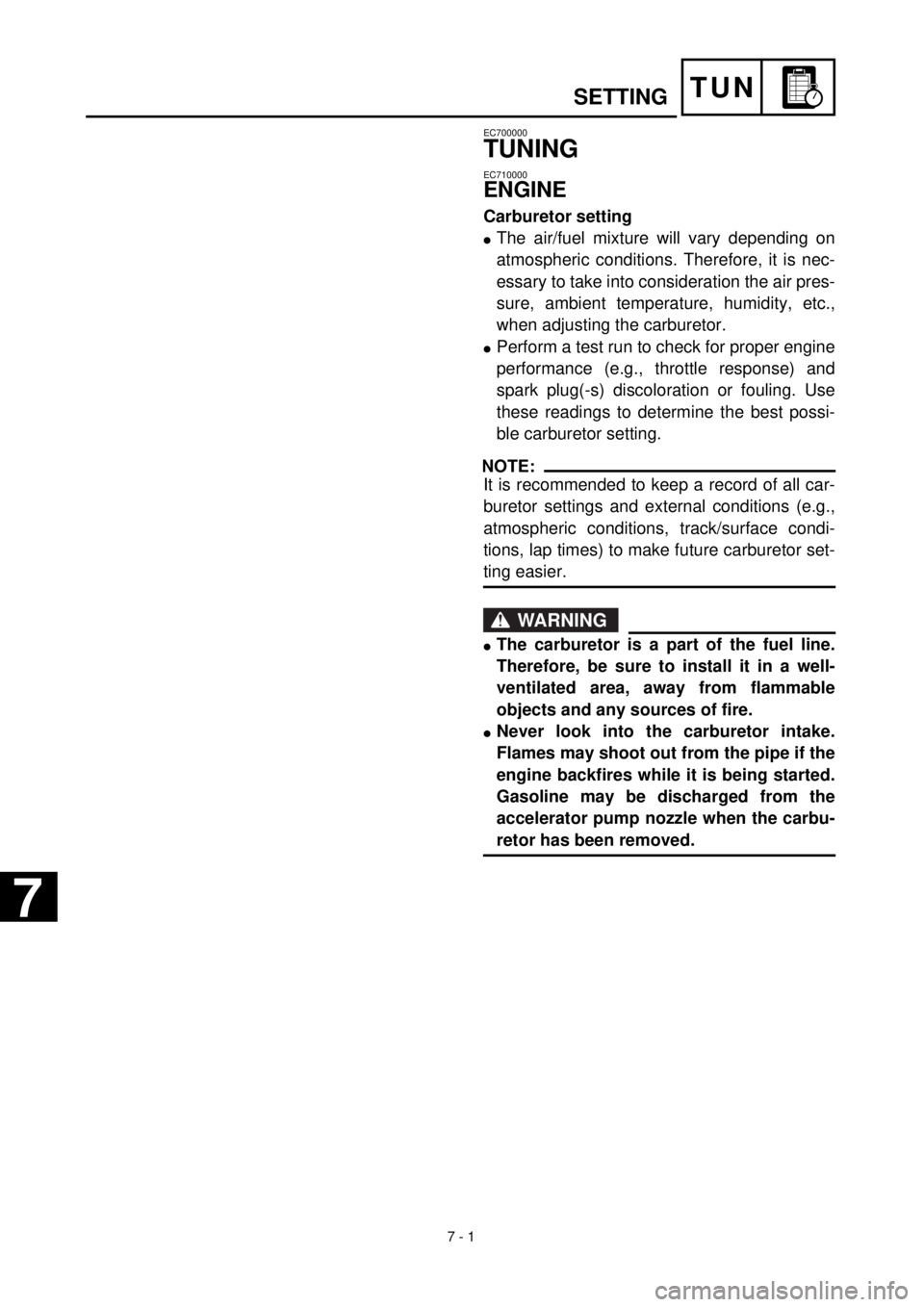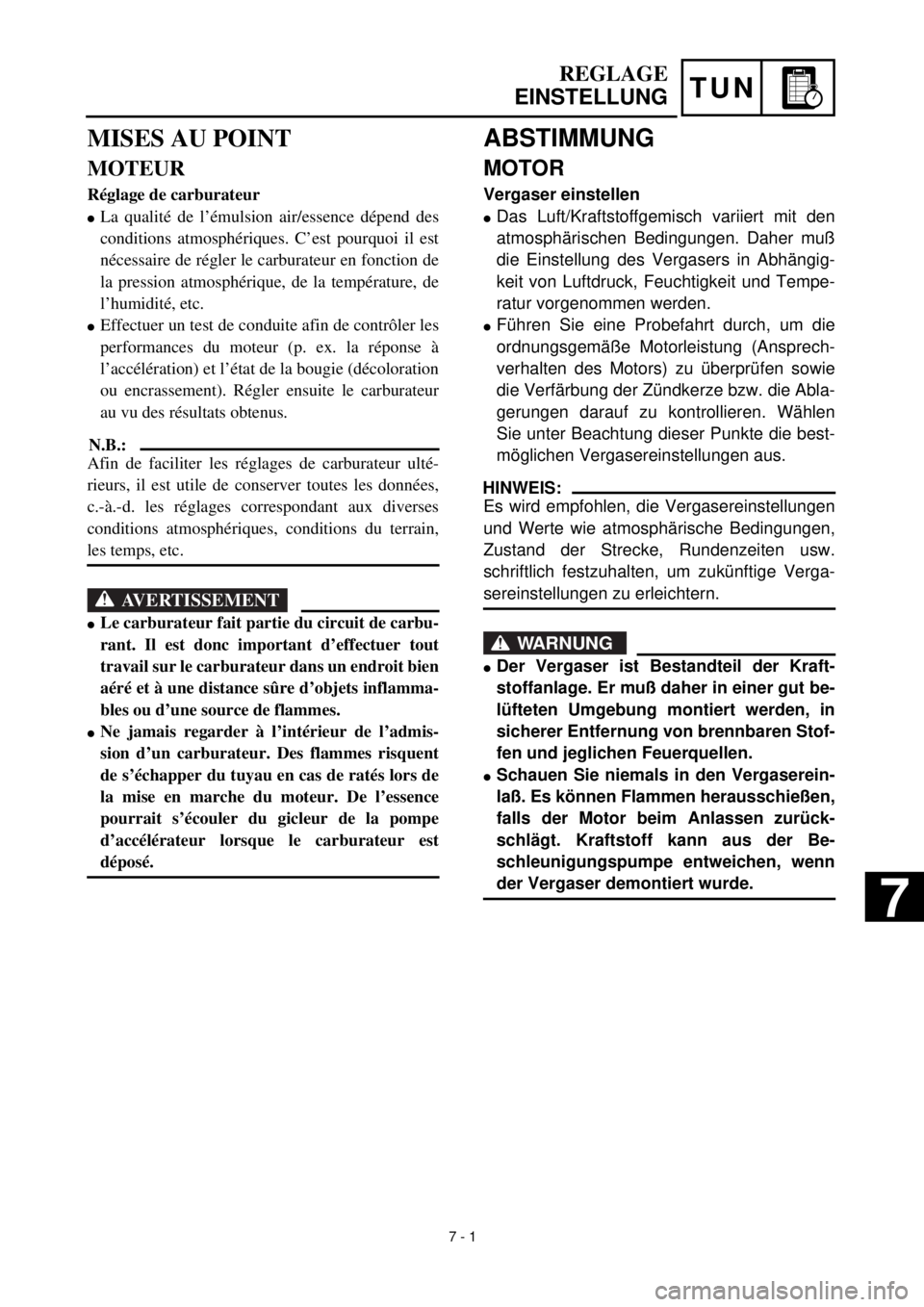YAMAHA YZ426F 2001 Owners Manual
Manufacturer: YAMAHA, Model Year: 2001, Model line: YZ426F, Model: YAMAHA YZ426F 2001Pages: 626, PDF Size: 47.57 MB
Page 571 of 626

–+ELEC
MEMO
Page 572 of 626

6 - 8
–+ELEC
TPS (THROTTLE POSITION SENSOR) SYSTEM
EC624000
COUPLERS AND LEADS CONNECTION
INSPECTION
1. Check:
l
Couplers and leads connection
Rust/dust/looseness/short-circuit
®
Repair or replace.
TPS COIL INSPECTION
1. Inspect:
l
TPS coil resistance
Out of specification
®
Replace.
2. Loosen:
l
Throttle stop screw
NOTE:
Turn out the throttle stop screw until the throt-
tle shaft is in the full close position.
Tester (+) lead
®
Blue lead
1
Tester (–) lead
®
Black lead
2
TPS coil
resistanceTester selector
position
4 ~ 6 k
W
at
20 ˚C (68 ˚F)k
W
´
1
3. Inspect:
l
TPS coil variable resistance
Check that the resistance in increased
as the throttle grip is moved from the
full close position to the full open posi-
tion.
Out of specification
®
Replace.
Tester (+) lead
®
Yellow lead
1
Tester (–) lead
®
Black lead
2
TPS coil variable
resistance
Tester selec-
tor position
Full closedFull opened
k
W
´
1 0 ~ 2 kW at
20 ˚C
(68 ˚F)4 ~ 6 kW at
20 ˚C
(68 ˚F)
Page 573 of 626

–+ELEC
INSPEKTION DER STECKVERBINDUNGEN
UND KABELANSCHLÜSSE
1. Prüfen:
l
Steckverbindungen und Kabelan-
schlüsse
Rost/Staub/Lockerung/Kurzschluß
®
Reparieren oder austauschen.
INSPEKTION DER TPS-SPULE
1. Prüfen:
l
Widerstand der TPS-Spule
Außerhalb des Sollwerts
®
Austau-
schen.
2. Lockerung:
l
Drosselklappen-Anschlagschraube
HINWEIS:
Die Drosselklappen-Anschlagschraube her-
ausdrehen, bis die Drosselklappenwelle voll-
ständig geschlossen ist.
Prüfgerätkabel (+)
®
Blaues Kabel
1
Prüfgerätkabel (–)
®
Schwarzes Kabel
2
TPS-Spulenwi-
derstandPrüfgerätein-
stellung
4–6 k
W
bei 20 ˚C k
W
´
1
3. Prüfen:
l
Regelwiderstand der TPS-Spule
Prüfen, ob sich der Widerstand erhöht,
während der geschlossene Gasdreh-
griff ganz aufgedreht wird.
Außerhalb des Sollwerts
®
Austau-
schen.
Prüfgerätkabel (+)
®
Gelbes Kabel
1
Prüfgerätkabel (–)
®
Schwarzes Kabel
2
TPS-Spulenwider-
stand
Prüfgerät-
einstellung
Ganz
geschlos-
senGanz
offen
k
W
´
1
0–2 k
W
bei 20 ˚C4–6 k
W
bei 20 ˚C
SYSTEME TPS (CAPTEUR DU PAPILLON D’ACCELERATION)
TPS-SYSTEM (DROSSELKLAPPEN-POSITIONSSENSOR)
CONTROLE DES CONNEXIONS DES
COUPLEURS ET DES FILS
1. Vérifier:
l
Connexion coupleurs et fils
Rouille/poussière/court-circuit
®
Réparer
ou remplacer.
CONTROLE DE LA BOBINE DE TPS
1. Contrôler:
l
Résistance de la bobine de TPS
Hors spécifications
®
Remplacer.
2. Serrer:
l
Vis d’arrêt d’accélérateur
N.B.:
Tourner la vis d’arrêt d’accélérateur jusqu’à ce que
l’axe de l’accélérateur soit en position de fermeture
complète.
Fil de l’appareil de contrôle (+)
®
Fil bleu
1
Fil de l’appareil de contrôle (–)
®
Fil noir
2
Résistance de la
bobine de TPS
Position du sélec-
teur de l’appareil
de contrôle
4 à 6 k
W
à
20 ˚C (68 ˚F)k
W
´
1
3. Contrôler:
l
Résistance variable de la bobine de TPS
S’assurer que la résistance augmente lors-
que la manette des gaz est tournée de la
position de fermeture complète à la position
d’ouverture complète.
Hors spécifications
®
Remplacer.
Fil de l’appareil de contrôle (+)
®
Fil jaune
1
Fil de l’appareil de contrôle (–)
®
Fil noir
2
Résistance variable de
la bobine de TPS
Position du
sélecteur de
l’appareil de
contrôle
Fermeture
complèteOuverture
complète
k
W
´
1
0 à 2 k
W
à
20 ˚C
(68 ˚F)4 à 6 k
W
à
20 ˚C
(68 ˚F)
6 - 8
Page 574 of 626

6 - 9
–+ELEC
TPS (THROTTLE POSITION SENSOR) SYSTEM
TPS REPLACEMENT AND ADJUSTMENT
1. Remove:
l
TPS coupler
l
Screw (TPS)
1
l
Plain washer
2
l
TPS
3
2. Replace:
l
TPS
3. Install:
l
TPS
1
l
Plain washer
2
l
Screw (TPS)
3
l
TPS coupler
NOTE:
l
Align the slot
a
in the TPS with the projec-
tion
b
on the carburetor.
l
Temporarily tighten the screws (TPS).
4. Adjust:
l
Idle speed
Refer to “IDLE SPEED ADJUSTMENT”
section in the CHAPTER 3.
5. Calculate:
l
TPS coil resistance at idle speed.
If the TPS coil resistance is 5 k
W
, then the TPS
coil resistance at idle speed is:
5 k
W
´
(0.13 ~ 0.15) = 650 ~ 750
W
Refer to “TPS COIL INSPECTION” sec-
tion about the TPS coil resistance.
TPS coil resistance at idle speed:
TPS coil resistance
´
(0.13 ~ 0.15)
Page 575 of 626

–+ELEC
TPS-AUSTAUSCH UND EINSTELLUNG
1. Entfernen:
l
TPS-Steckverbindung
l
Schraube (TPS)
1
l
Unterlegscheibe
2
l
TPS
3
2. Austauschen:
l
TPS
3. Einbauen:
l
TPS
1
l
Unterlegscheibe
2
l
Schraube (TPS)
3
l
TPS-Steckverbindung
HINWEIS:
l
Die Kerbe
a
im TPS auf den Vorsprung
b
am Vergaser ausrichten.
l
Die Schrauben (TPS) vorübergehend fest-
ziehen.
4. Einstellen:
l
Leerlaufdrehzahl
Siehe hierzu den Abschnitt “EINSTEL-
LUNG DER LEERLAUFDREHZAHL” in
KAPITEL 3.
5. Errechnen:
l
TPS-Spulenwiderstand bei Leerlauf
Wenn der TPS-Spulenwiderstand weniger als
5 k
W
beträgt, dann ist der TPS-Spulenwider-
stand bei Leerlauf:
5 k
W
´
(0,13–0,15) = 650–750
W
Zum TPS-Spulenwiderstand bitte mit
dem Abschnitt “INSPEKTION DES
TPS-SPULENWIDERSTANDS” ver-
gleichen. TPS-Spulenwiderstand bei Leerlauf
TPS-Spulenwiderstand ´ (0,13–0,15)
REMPLACEMENT ET REGLAGE DU TPS
1. Déposer:
lCoupleur du TPS
lVis (TPS) 1
lRondelle ordinaire 2
lTPS 3
2. Remplacer:
lTPS
3. Installer:
lTPS 1
lRondelle ordinaire 2
lVis (TPS) 3
lCoupleur TPS
N.B.:
lAligner la fente a pratiquée dans le TPS sur la
saillie b du carburateur.
lSerrer temporairement les vis (TPS).
4. Ajuster:
lVitesse de ralenti
Voir la section “Réglage de la vitesse de
ralenti” dans le CHAPITRE 3.
5. Calculer:
lRésistance de la bobine de TPS au ralenti.
Si la résistance de la bobine de TPS est de 5 kW, la
résistance de la bobine de TPS au ralenti sera:
5 kW ´ (0,13 à 0,15) = 650 à 750 W
Voir la section “Contrôle de la bobine de
TPS” pour la résistance de la bobine de
TPS. Résistance de la bobine de TPS au ralenti:
Résistance de la bobine de TPS ´
(0,13 à 0,15)
SYSTEME TPS (CAPTEUR DU PAPILLON D’ACCELERATION)
TPS-SYSTEM (DROSSELKLAPPEN-POSITIONSSENSOR)
6 - 9
Page 576 of 626

6 - 10
–+ELEC
TPS (THROTTLE POSITION SENSOR) SYSTEM
6. Adjust:
l
TPS coil resistance at idle speed
Adjustment steps:
Adjust the angle of the TPS
1
to obtain
the resistance calculated (example: 650 ~
750
W
)
Tester (+) lead
®
Yellow lead
2
Tester (–) lead
®
Black lead
3
7. Tighten:
l
Screw (TPS)
1
8. Install:
l
TPS coupler
EC694000
TPS INPUT VOLTAGE INSPECTION
1. Disconnect the TPS coupler.
2. Start the engine.
3. Inspect:
l
TPS input voltage
Out of specification
®
Replace the CDI
unit.
Tester (+) lead
®
Blue lead
1
Tester (–) lead
®
Black lead
2
TPS input
voltageTester selector
position
4 ~ 6 V DCV-20
Page 577 of 626

–+ELEC
6. Einstellen:
lTPS-Spulenwiderstand bei Leerlauf
7. Festziehen:
lSchraube (TPS) 1
8. Einbauen:
lTPS-Steckverbindung Einstellung
Den Winkel des TPS 1 einstellen, um den
errechneten Widerstand zu erzielen
(Beispiel: 650–750 W).
Prüfgerätkabel (+) ® Gelbes Kabel 2
Prüfgerätkabel (–) ® Schwarzes Kabel 3
PRÜFEN DER TPS-EINGANGSSPANNUNG
1. Die TPS-Steckverbindung trennen.
2. Den Motor starten.
3. Prüfen:
lTPS-Eingangsspannung
Außerhalb des Sollwerts ® Die CDI-
Einheit austauschen.
Prüfgerätkabel (+) ® Blaues Kabel 1
Prüfgerätkabel (–) ® Schwarzes Kabel 2
TPS-Eingangs-
spannung Prüfgerätein-
stellung
4–6 V DCV-20
6. Régler:
lRésistance de la bobine de TPS à la vitesse
de ralenti
7. Serrer:
lVis (TPS) 1
8. Installer:
lCoupleur TPS Ordre de réglage:
Régler l’angle du TPS 1 pour obtenir la résis-
tance (exemple: 650 à 750 W).
Fil de l’appareil de contrôle (+) ®
Fil jaune 2
Fil de l’appareil de contrôle (–) ® Fil noir 3
CONTROLE DE LA TENSION D’ENTREE
DU TPS
1. Débrancher le coupleur de TPS.
2. Démarrer le moteur.
3. Contrôler:
lTension d’entrée du TPS
Hors spécifications ® Remplacer le bloc
CDI.
Fil de l’appareil de contrôle (+) ® Fil bleu 1
Fil de l’appareil de contrôle (–) ® Fil noir 2
Tension d’entrée
du TPS Position du sélec-
teur de l’appareil
de contrôle
4 à 6 V DCV-20
SYSTEME TPS (CAPTEUR DU PAPILLON D’ACCELERATION)
TPS-SYSTEM (DROSSELKLAPPEN-POSITIONSSENSOR)
6 - 10
Page 578 of 626

7 - 1
TUN
EC700000
TUNING
EC710000
ENGINE
Carburetor setting
lThe air/fuel mixture will vary depending on
atmospheric conditions. Therefore, it is nec-
essary to take into consideration the air pres-
sure, ambient temperature, humidity, etc.,
when adjusting the carburetor.
lPerform a test run to check for proper engine
performance (e.g., throttle response) and
spark plug(-s) discoloration or fouling. Use
these readings to determine the best possi-
ble carburetor setting.
NOTE:
It is recommended to keep a record of all car-
buretor settings and external conditions (e.g.,
atmospheric conditions, track/surface condi-
tions, lap times) to make future carburetor set-
ting easier.
WARNING
lThe carburetor is a part of the fuel line.
Therefore, be sure to install it in a well-
ventilated area, away from flammable
objects and any sources of fire.
lNever look into the carburetor intake.
Flames may shoot out from the pipe if the
engine backfires while it is being started.
Gasoline may be discharged from the
accelerator pump nozzle when the carbu-
retor has been removed.
SETTING
7
Page 579 of 626

TUN
ABSTIMMUNG
MOTOR
Vergaser einstellen
l
Das Luft/Kraftstoffgemisch variiert mit den
atmosphärischen Bedingungen. Daher muß
die Einstellung des Vergasers in Abhängig-
keit von Luftdruck, Feuchtigkeit und Tempe-
ratur vorgenommen werden.
l
Führen Sie eine Probefahrt durch, um die
ordnungsgemäße Motorleistung (Ansprech-
verhalten des Motors) zu überprüfen sowie
die Verfärbung der Zündkerze bzw. die Abla-
gerungen darauf zu kontrollieren. Wählen
Sie unter Beachtung dieser Punkte die best-
möglichen Vergasereinstellungen aus.
HINWEIS:
Es wird empfohlen, die Vergasereinstellungen
und Werte wie atmosphärische Bedingungen,
Zustand der Strecke, Rundenzeiten usw.
schriftlich festzuhalten, um zukünftige Verga-
sereinstellungen zu erleichtern.
WARNUNG
l
Der Vergaser ist Bestandteil der Kraft-
stoffanlage. Er muß daher in einer gut be-
lüfteten Umgebung montiert werden, in
sicherer Entfernung von brennbaren Stof-
fen und jeglichen Feuerquellen.
l
Schauen Sie niemals in den Vergaserein-
laß. Es können Flammen herausschießen,
falls der Motor beim Anlassen zurück-
schlägt. Kraftstoff kann aus der Be-
schleunigungspumpe entweichen, wenn
der Vergaser demontiert wurde.
REGLAGE
EINSTELLUNG
MISES AU POINT
MOTEUR
Réglage de carburateur
l
La qualité de l’émulsion air/essence dépend des
conditions atmosphériques. C’est pourquoi il est
nécessaire de régler le carburateur en fonction de
la pression atmosphérique, de la température, de
l’humidité, etc.
l
Effectuer un test de conduite afin de contrôler les
performances du moteur (p. ex. la réponse à
l’accélération) et l’état de la bougie (décoloration
ou encrassement). Régler ensuite le carburateur
au vu des résultats obtenus.
N.B.:
Afin de faciliter les réglages de carburateur ulté-
rieurs, il est utile de conserver toutes les données,
c.-à.-d. les réglages correspondant aux diverses
conditions atmosphériques, conditions du terrain,
les temps, etc.
AVERTISSEMENT
l
Le carburateur fait partie du circuit de carbu-
rant. Il est donc important d’effectuer tout
travail sur le carburateur dans un endroit bien
aéré et à une distance sûre d’objets inflamma-
bles ou d’une source de flammes.
l
Ne jamais regarder à l’intérieur de l’admis-
sion d’un carburateur. Des flammes risquent
de s’échapper du tuyau en cas de ratés lors de
la mise en marche du moteur. De l’essence
pourrait s’écouler du gicleur de la pompe
d’accélérateur lorsque le carburateur est
déposé.
7 - 1
7
Page 580 of 626

7 - 2
TUN
CAUTION:
lThe carburetor is extremely sensitive to
foreign matter (dirt, sand, water, etc.).
During installation, do not allow foreign
matter to get into the carburetor.
lAlways handle the carburetor and its
components carefully. Even slight
scratches, bends or damage to carbure-
tor parts may prevent the carburetor from
functioning correctly. Carefully perform
all servicing with the appropriate tools
and without applying excessive force.
lWhen the engine is stopped or when
riding at no load, do not open and close
the throttle unnecessarily. Otherwise, too
much fuel may be discharged, starting
may become difficult or the engine may
not run well.
lAfter installing the carburetor, check that
the throttle operates correctly and opens
and closes smoothly.
Atmospheric conditions and carburetor
settings
The air density (i.e., concentration of oxygen
in the air) determines the richness or lean-
ness of the air/fuel mixture. Therefore, refer
to the above table for mixture settings.
That is:
lHigher temperature expands the air with its
resultant reduced density.
lHigher humidity reduces the amount of oxy-
gen in the air by so much of the water vapor
in the same air.
lLower atmospheric pressure (at a high alti-
tude) reduces the density of the air.
Air temp. HumidityAir
pressure
(altitude)Mixture Setting
High High Low (high) Richer Leaner
Low Low High (low) Leaner Richer
SETTING